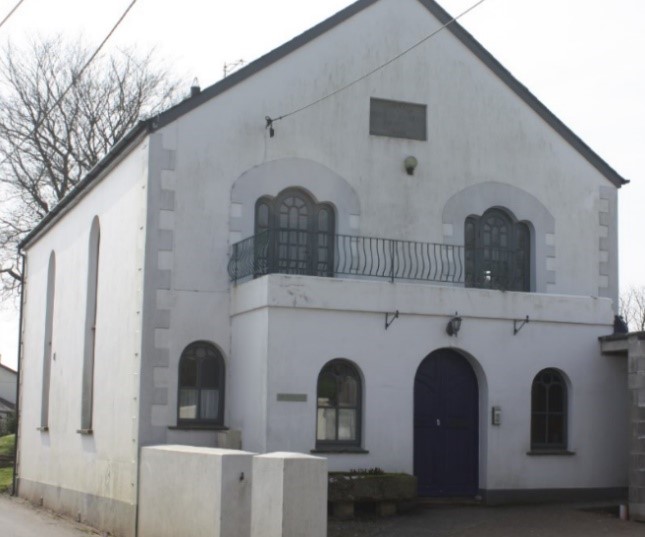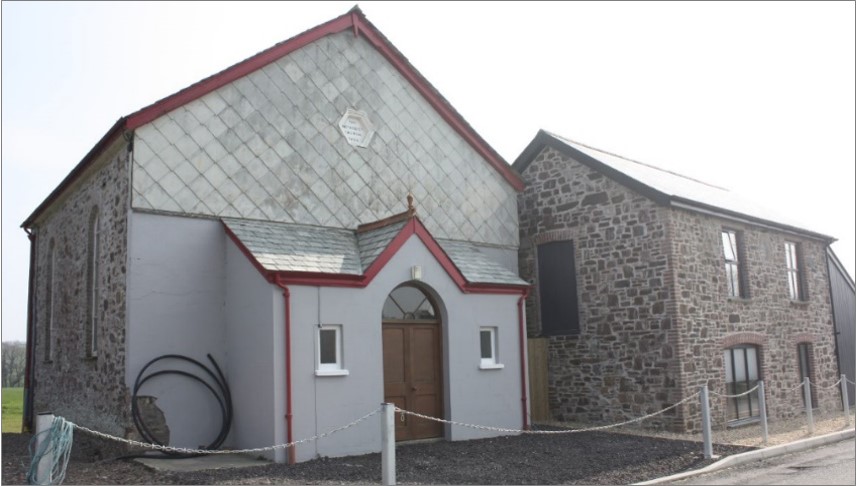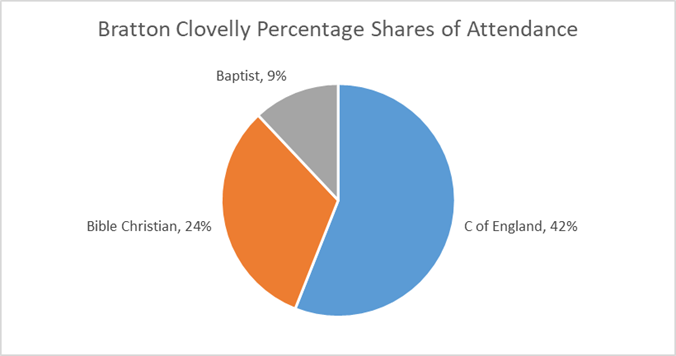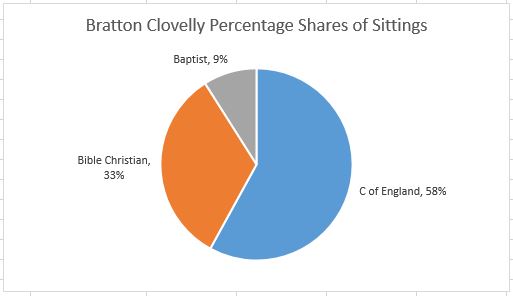Until the 19th century, Bratton Clovelly had been a parish of one religion, the Church of England. In the Compton Census of 1676, the Okehampton District registered over 3600 conformists compared with 21 nonconformists and 7 Papists, with Bratton failing to even report. However, new dissent did arrive and by the mid-1800s the parish was home to several Protestant denominations. Note that the smaller detached part of the parish shown below was re-districted to Broadwoodwidger in 1885.
This research was done under the guidance of the Family and Community Historical Research Society (FACHRS), with members investigating their particular community of interest in a project called Communities of Dissent. The following write-up summmarises key findings of Phase 1 of the project, where a Dissent profile of each place was built. The full Bratton Clovelly Phase 1 article with references is available from this link.

Bratton Clovelly Places of Worship
Base maps: 1851 jurisdictions at familysearch.org, 1845 Tithe Maps at Devon Heritage Centre
Church of England
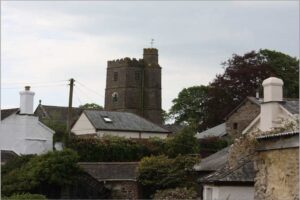
Church of St Mary overlooking the village
The Church of England is ancient and historically strong in Bratton Clovelly. Although the doorstep with Roman inscriptions indicates possibly earlier beginnings, documentation identifies that Bishop Grandisson acquired the patronage of St Mary’s in 1335-6. A plaque hangs in the church containing the List of Incumbents for St Mary’s from 1321-2010.
The Church overlooks the village, welcoming the visitor with a striking Norman baptismal font and 17th century wall paintings. St Mary’s living was an attractive one and church leadership remained stable, with learned 19th-century incumbents serving on average 20 years. The Church functioned at the heart of the community, central to such initiatives as the opening of the first school in 1837. See the Listed Buildings theme for more information on this church.
Bible Christians
So it is not surprising that dissent came late to Bratton Clovelly, the Episcopal Visitation Returns of 1779 reporting that ‘We have not any reputed Papists, nor dissenting Congregations’. This appears to have continued into the early 1800s, probably first disrupted by the charismatic Cornish preacher William O’Bryan who founded Bible Christianity, an offshoot of Wesleyan Methodism. Seven members formed a Bible Christian Society in the parish in 1818, just a few years after the denomination originated and only ten miles south of its epicentre in Shebbear, Devon. Three Bible Christian chapels, actually four with one being replaced early on, were founded in the mid-1800s in the parish, beginnings which would provide the story of dissent in the parish to the present day. Time has been kind to the history of Bratton Clovelly and much can still be seen in situ.
Gilgal Chapel was registered with the Diocese of Exeter in 1834 as a Meeting House for ‘Protestant Dissenters from the Church of England of the denomination of Arminian Bible Christians otherwise Bryanites’. It appears on the 1845 Tithe map owned by and next door to the longhouse of Thomas Roberts, the local blacksmith. It reported 60 attendees in the 1851 census.
Providence Chapel was built in 1859, across the lane from and as a replacement for Gilgal. Gilgal continued as a Sunday School until a new school was built in 1888 now called ‘The Old Sunday School’. Providence Chapel was reunified with other branches of the United Methodist Church in 1907 and the Methodist Church in 1932. It was a place of worship until 1983 and is now a private residence.
In an 8,000 acre parish, it might be anticipated that other chapels would be needed to reach the scattered population. Boasley Chapel was erected on the eastern side of the parish in 1838 and remains an active Methodist Church today. Over 100 people attended services on 30 March 1851 including Sunday School scholars. It had been the intent of a local landowner, John Hatch, to accommodate the Bible Christians on his property, an intent carried out by his representatives following his decease, and according to the Bible Christian Magazine of 1867, his eight Hatch daughters of Boasley Farm had ‘long been friends of our Body’.
In 1860, Rexon Cross Chapel opened in the southwest of the parish about four miles from Providence Chapel in the village and seven miles from Boasley. It was built in 1860 and a Sunday School building was added in 1868. This chapel was part of the Bible Christian Launceston Circuit while the other chapels in Bratton Clovelly were part of the Northlew Circuit. It closed its doors for worship in 2013 and is now part of Rexon Farm.

‘The Old Sunday School’, Village built in 1888
adjoining site of original Gilgal chapel built in 1834

Salem Chapel, Boasley built in 1838,
re-built in 1904, still holding services today
© Copyright Derek Harper, CCA
Wesleyan Methodists
The Wesleyan Methodist denomination, providing the principles upon which Bible Christianity was based, had most of its impact in the nucleated mining villages of Cornwall and towns such as Okehampton. Sparsely populated West Devon was only lightly covered. However, Broxcombe Farm in Bratton Clovelly became a small public place of worship for the Wesleyans from 1836 to 1842. The handful of families in this Society lived on a few isolated farms near the moorlands to the north of the parish and most appear to have emigrated to Canada in the early 1840s. For the purposes of this study, this group will be considered alongside the Bible Christians.
Baptists
A Baptist group also appears in the 1851 Ecclesiastical Census, having formed in 1843 and meeting in a private home at Barton Court in Bratton Village. On 30 March 1851, 28 attended the morning service and 34 in the afternoon. The 1851 return was signed by Thomas Rice who appears to have been an agricultural labourer sharing ownership of a freehold in Barton Court with John Knight, believed to be a Bible Christian minister since the early days of the denomination. In addition, Thomas shared tenancy of the house with James Knight, brother of John, who was one of the three signatories to the original Bible Christian Meeting House certificate for the parish in 1834. Although the members of the Baptist congregation are unknown, many of the heads of households and their spouses in Barton Court were elderly and died between 1841 and 1861. This group has not been further researched due to a complete lack of evidence apart from the religious census.
Other Places of Worship
Due to the size of the parish, conformist and non-conformist residents especially in the north of the parish, and the detached western part, were worshipping in adjoining parishes, especially Broadwoodwidger, Germansweek and Beaworthy (see Figure 6). In addition, a large number of Bratton Clovelly residents had been born in other parishes often within 5-10 miles. The Church of England parish registers for these parishes are accessible online and many of their nonconformist places of worship are in the same Bible Christian and Wesleyan Circuit Books as Bratton Clovelly chapels, sources which will be considered in further research of the parish.
Buildings
1851 Religious Census
In 1851, a unique survey was taken of all the religious places of worship existing at that time in England and Wales. As well as identifying the places, the survey requested the number of sittings available and the number of people in attendance at each place on the day of the survey. This information provided a detailed snapshot of religious practices, a survey not repeated again for the whole country. 42% of Bratton Clovelly attended St Mary’s Church of England on the survey day while 32% attended the Bible Christian and Baptist places of worship on that day. This compares with 40% Church of England attendees and 26% nonconformist attendees across the county of Devon.
Regional Influences
To the east of Bratton Clovelly, the Church of England stronghold in the Exeter Diocese manifested itself in Exeter’s 84.5% index of attendance in the 1851 religious census, topping the table of large towns with a 54.7% index of attendance for the Church of England. To the west of the parish, the Wesleyan impact on the mining communities in the west of Cornwall manifested itself in a 43.8% index of attendance for Methodists , the highest Methodist index of any English county. To the South, the impact of extraordinary growth on Plymouth manifested itself in a general lack of attendance, overshadowed by reports from the urban North but noteworthy in the Southwest.
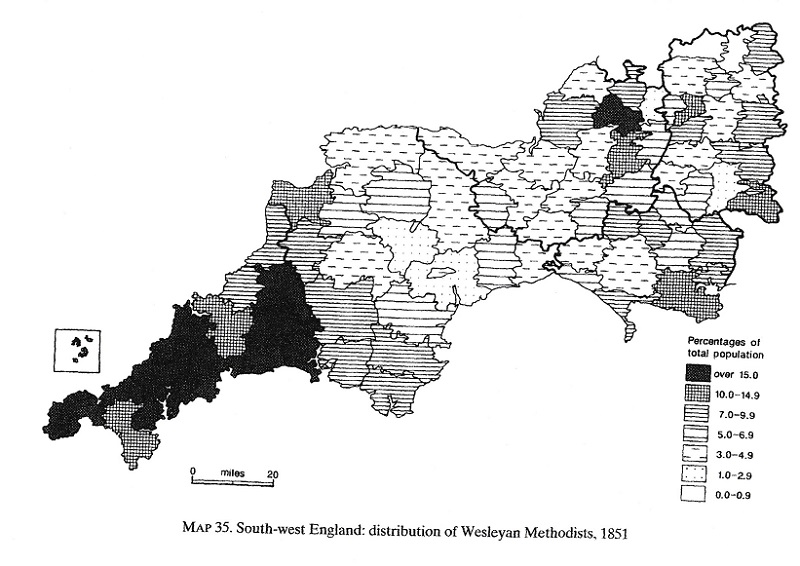
Wesleyan Methodist Distribution in Southwest England
K Tiller, ‘Religion in 19th Century Britain’, Communities and Families (1994)
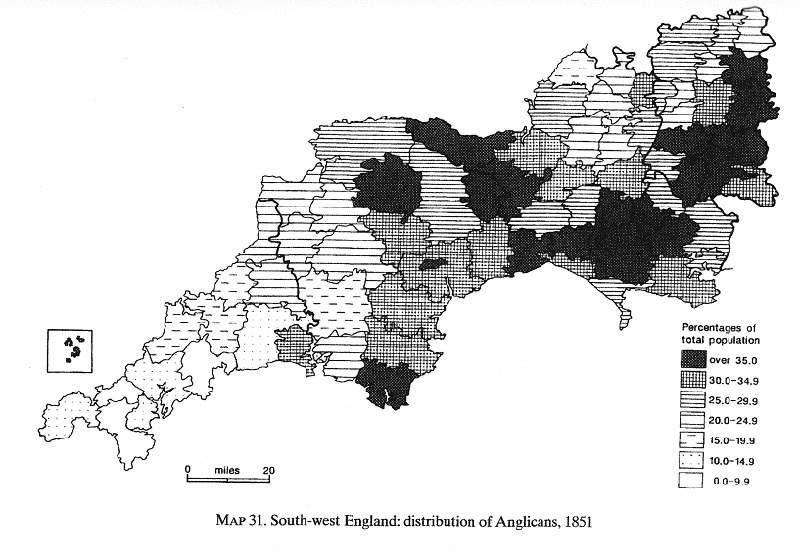
Anglican (C of E) Distribution in Southwest England
K Tiller, ‘Religion in 19th Century Britain’, Communities and Families (1994)
Remaining was the area in the middle including the West Devon parish of Bratton Clovelly. Surrounded by such powerful and contrasting influences, it is little wonder that both the Church of England and the Methodists would be substantially represented amongst the parish worshippers. In addition, the parish’s history of a strong local church meant that the addition of a large group of chapelgoers to an already fairly robust community of churchgoers would result in an overall index of attendance that reflected a religious fervour able to sustain its institutions through the onslaught of the 20th century.
The different regions of religious influence in the Southwest emphasise the danger of generalisations without grounding in the local experience. Often, the Southwest of England is grouped into statistics overwhelmed by the Wesleyan miners, or the county of Devon is grouped into statistics overwhelmed by the Anglicanism of Exeter. Rural agricultural landscapes like Bratton Clovelly can escape notice but speak to the lives of many in the Victorian Southwest.
It was a small group of deeply committed local evangelists, the Bible Christians, who saw the opportunity in this part of West Devon and East Cornwall. Speaking of the area between Langtree and Brentor, stretching just 20 miles and including Bratton Clovelly, the spiritual leader of the Bible Christians James Thorne recollected in 1868:
‘The large tract of country between those places, before it was visited by Bible Christian ministers, was in a deplorable state of spiritual darkness.’ (J Thorne, A Jubilee Memorial of Incidents in the Rise and Progress of the Bible Christian Connexion, 1865, p. 193)
To the Bible Christians who had little interest in proselytizing, ‘spiritual darkness’ meant an absence of attention from dissenting groups. Their itinerant ministers pursued punishing schedules of travel through rugged countryside to reach isolated farmsteads where they worked to save souls one by one.

Bible Christian Impact (white squares) on Southwest England
H McLeod, Religion and Society in England, 1850-1914, 1996
The small size, relative isolation and limited diversity of Bratton Clovelly, along with a plethora of accessible resources, now afford the opportunity to pinpoint many of the souls who were being saved. Were they the ‘poor and ignorant’ sometimes assumed to be those most attracted by evangelical revivals and dramatic conversions? Did they live on the fringes of their communities with their notions of temperate discipline? Did they live, marry, work or move together? Did their congregations rise and fall with the rise and fall of the parish, or were there other drivers?
Early indications are that an examination of Bratton Clovelly’s nonconformity at the level of individuals may challenge some of the more prominent generalisations regarding evangelistic congregations, patterns of kinship relations and patterns of migration in this timeframe. Preliminary research on the parish points to a possibly intricate web of interrelated phenomena where nonconformity is a key component.
